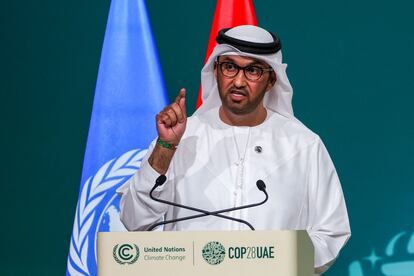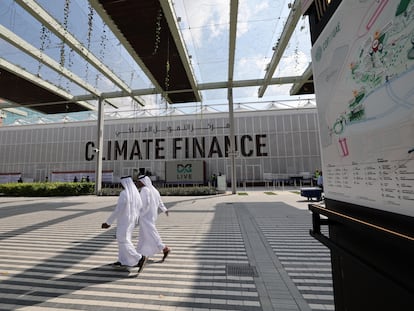What are carbon credits and what do they mean for the Global South?
These tools allow companies and individuals to offset their emissions, but face criticism over their effectiveness and integrity

The world has more than 190 countries, but only one atmosphere and less than a decade to implement joint solutions to irreversible changes in the climate. In this context, carbon markets and emissions compensation have become one of the burning issues at the United Nations Climate Change Summit (COP28), which is being held in Dubai until December 12. These carbon credits can be a source of financing for the Global South, but their effectiveness and whether they have allowed abuses against local communities have come under close scrutiny.
What are carbon credits and how do they offset emissions?
Carbon markets are a strategy to confront climate change based on a simple economic principle: putting a price on greenhouse gas emissions incentivizes emitters to reduce them. In these markets, emissions rights known as carbon credits are traded — each credit represents one ton of carbon dioxide or the equivalent amount of another greenhouse gas, such as methane emanating from livestock and landfills.
The idea is that companies, institutions, and individuals can offset their emissions by investing in initiatives that absorb the same amount of CO₂ in other parts of the planet, since the atmosphere is the same everywhere. For example, an airline can buy carbon credits for a project that restores rainforests in Africa, so that what its planes emit is offset by what the trees absorb.
What are Carbon Credits and why are we investing in Africa's Carbon Markets? Let's hear from @jmcurtin on how removing carbon emissions has become at tradable commodity. #ACS23 #AfricaClimatesummit23 pic.twitter.com/Kgz9ZkqTSx
— The Rockefeller Foundation (@RockefellerFdn) September 5, 2023
Do they serve to stop deforestation in developing countries?
There are two types of carbon markets: in the mandatory markets, there are regulations that force public and private entities to keep their emissions below a certain threshold, and to pay heavy fines if this is not the case. In voluntary markets, entities can choose to offset their emissions for ethical reasons or to improve their reputation, as is the case with airlines.
Voluntary markets matter because they are a source of climate finance for communities and Indigenous peoples in the Global South. In countries such as Indonesia, Colombia, and Kenya, carbon credits finance projects to restore and protect threatened forests that would not be possible otherwise.
These initiatives, known as REDD+ (Reducing Emissions from Deforestation and Forest Degradation), seek to offer an alternative source of income to impoverished communities that, without them, would face a difficult choice: open their forests to logging companies and commercial plantations to earn a living, or to keep them and give up on improving their economic situation in the short term.
In an open letter, Indigenous organizations working in more than 40 countries in the Global South recently stated that carbon projects are one of the few sources of money available to communities seeking to develop sustainably. Every year, deforestation devastates an area the size of Iceland.
Why are carbon credits controversial?
This year, however, scientific research exposed a voluntary carbon market that was already drawing criticism for irregular practices in the sector. The study concluded that more than 90% of carbon credits linked to tropical forests and certified by Verra — the main carbon standard for voluntary markets — were worthless. In other words, they came from projects that were not helping to reduce deforestation and were therefore neither avoiding emissions nor entitled to generate carbon credits.
Those who oppose carbon markets consider that they are diverting attention from the profound reforms that must be implemented in terms of energy production and consumption in the world. They also argue that companies should work to actually reduce their emissions, rather than just offset them — a view shared by those who support carbon credits.
Finally, they maintain that it is not possible to calculate future emissions that have been “avoided” by projects that are seeking to reduce deforestation because no one can accurately predict what would have happened in the future. As a result of the aforementioned controversy, Verra has been working on improving its certification standards.
What are “carbon cowboys” and what abuses can tropical forest communities around the world be exposed to?
As with the gold rush, the opportunity to make money with carbon credits has attracted opportunistic, inept, and unscrupulous characters who have sought to line their pockets by taking advantage of the global imperative to protect forests and the communities that inhabit them. These individuals are known as “carbon cowboys,” an allusion to the carbon markets as a lawless place where anything goes, similar to the Wild West.
Their main targets are Indigenous or local communities with little or no knowledge on the subject, in areas that are difficult to access, and in countries with weak forest governance; that is, with few regulations or a lack of means to enforce the laws. Corrupting local or national authorities is another means by which “carbon cowboys” clear the way to conduct their business.
The most frequent abuses faced by forestry communities in the Global South have to do with the lack of free, prior, and informed consent, which often manifests itself in expeditious campaigns to obtain the signatures of local leaders on abusive contracts. Then there is the opacity in the credits that are sold and for how much money, because the communities can hardly control if they are obtaining the benefits that are due to them from the sales.
What are some examples of irregular carbon projects?
EL PAÍS has published research showing how millions of hectares of Congolese forest had been converted into concessions for carbon projects without the communities’ knowledge, and how a project in Colombia sold carbon credits without the knowledge of the communities, to whom part of the money is owed.
The work in Colombia led a judge to suspend the project being carried out without the community. Meanwhile, the one carried out in the Democratic Republic of the Congo resulted in an official requirement (from the Interministerial Commission for the Review of Forest Contracts) to create a framework legislation that fills the current gaps in carbon projects.
In places like Papua, the promoters of a REDD+ project had promised the communities an income in exchange for protecting the forest, but when this did not materialize, the communities ended up letting a logging company in.
Far from the jungles, in Kenya’s arid lands, the NGO Survival has recently highlighted irregularities in a carbon project in traditional pastoral areas, pointing out the impacts it may have on ancestral ways of life, among other technical issues relative to prior consultation processes.
What do scientists say about REDD+ projects?
For the authors of the study on forest-based carbon credits, and other members of the scientific community, carbon credits are not a panacea. Rather, they are one more weapon in the arsenal of policies that the world must improve and deploy to curb the worst effects of climate change.
And at a time when there is hardly any direct climate financing for indigenous and local organizations, REDD+ projects can be a way to encourage communities in the Global South to continue protecting forests, especially tropical forests, for the benefit of all.
When will there be a mandatory global carbon market?
The European Union (EU) has one of the largest mandatory markets, which sets emissions limits for companies in the industrial and energy sector and the fines for violators. With this system, companies that pollute the most can offset their carbon footprint by purchasing emissions certificates for those that do not hit their limit. The European Commission estimates that, thanks to this mechanism, emissions from regulated companies fell by 35% between 2005 and 2021.
What does not yet exist is a global mandatory market, supervised by the United Nations, to regulate the exchange of emission rights between countries in the Global North and South. COP28 will seek to advance the implementation of this system, provided for in Article 6 of the Paris Agreement and which has been pending since it was signed in 2015.
More than 80% of countries’ climate commitments include international carbon markets as a way to reduce emissions. In turn, this could mean a sizeable injection of funds for developing countries to improve their adaptation to climate change.
Why is it so difficult to agree on emissions trading between countries?
From the beginning, structuring a mandatory global gas emission rights market has been one of the most complex aspects of the Paris Agreement.
One of the biggest challenges is keeping track of avoided emissions. That is, creating an accounting system to prevent different bodies — such as a government and a company that operates in its territory — from taking credit for the same reduction. Other challenges include agreeing on credible safeguards against potential human rights abuses, such as land theft; and put a stop to “greenwashing,” attempts by some brands to pass off operations or products that are not green as being environmentally friendly.
Be that as it may, experts agree that transparency, the quality of emissions certification, registration and monitoring systems, and integrity must be at the base of any market mechanism that aspires to contribute to the battle for climate.
Sign up for our weekly newsletter to get more English-language news coverage from EL PAÍS USA Edition
Tu suscripción se está usando en otro dispositivo
¿Quieres añadir otro usuario a tu suscripción?
Si continúas leyendo en este dispositivo, no se podrá leer en el otro.
FlechaTu suscripción se está usando en otro dispositivo y solo puedes acceder a EL PAÍS desde un dispositivo a la vez.
Si quieres compartir tu cuenta, cambia tu suscripción a la modalidad Premium, así podrás añadir otro usuario. Cada uno accederá con su propia cuenta de email, lo que os permitirá personalizar vuestra experiencia en EL PAÍS.
¿Tienes una suscripción de empresa? Accede aquí para contratar más cuentas.
En el caso de no saber quién está usando tu cuenta, te recomendamos cambiar tu contraseña aquí.
Si decides continuar compartiendo tu cuenta, este mensaje se mostrará en tu dispositivo y en el de la otra persona que está usando tu cuenta de forma indefinida, afectando a tu experiencia de lectura. Puedes consultar aquí los términos y condiciones de la suscripción digital.
More information
Últimas noticias
Most viewed
- Reinhard Genzel, Nobel laureate in physics: ‘One-minute videos will never give you the truth’
- Oona Chaplin: ‘I told James Cameron that I was living in a treehouse and starting a permaculture project with a friend’
- Pablo Escobar’s hippos: A serious environmental problem, 40 years on
- Why we lost the habit of sleeping in two segments and how that changed our sense of time
- Charles Dubouloz, mountaineering star, retires at 36 with a farewell tour inspired by Walter Bonatti









































